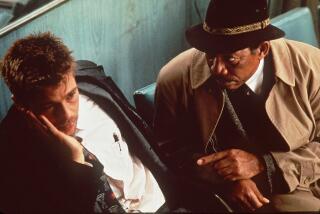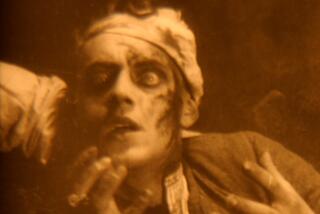Years Later, He’s Still a Poster Boy for Films
- Share via
Mike Kaplan claims he was born with a poster gene.
As a 10-year-old, he would commandeer the Sunday paper and carefully color in the black-and-white advertisements for the latest Broadway shows. Now a producer and independent filmmaker, the grown-up Kaplan collects vintage movie posters -- he has more than a thousand from all over the world.
And some 70 of his choicest posters are on exhibit in an inaugural show devoted to the art of the movie poster at Cal State Northridge’s new permanent gallery.
Posters, which often offer the first glimpse of a new movie, can either pique the public’s interest or serve as the visual equivalent of a bad review. And like the rare TV commercial that achieves greatness, the best posters transcend their mercantile purpose.
As John Schultheiss, a poster collector and chairman of Northridge’s department of cinema and television arts, said: “What began as a throwaway advertisement with an expected life of only a couple of weeks has become an art form in its own right.”
Schultheiss first dreamed of hanging movie posters on the bare walls of the university’s 120-seat Alan and Elaine Armer Theater, which opened in 2002. And he knew exactly where to find them. He was stunned by Kaplan’s posters the first time he visited the filmmaker’s Westside home several years ago: “The whole house was like a museum,” Schultheiss recalled.
The exhibit in Northridge was organized around the theme “Hollywood Worldwide,” with an eye to revealing the artfulness, power and universality of the movie poster, especially during its golden age, from the 1930s through the 1950s.
Many vintage posters feature screen goddesses, including Marilyn Monroe on an Italian poster for “Some Like It Hot,” and matinee idols, including James Dean brooding on a poster from Argentina for “Gigante.”
Flanking the theater entrance are French posters by Boris Grinnson -- an artist popular in half a dozen countries -- for 1942’s “Sullivan’s Travels” and 1950’s “Sunset Boulevard.”
Posters for those two films are perfect for a campus cinematheque, said Schultheiss, because “those are meta-movies, movies about movies.”
The exhibit -- which is free and continues indefinitely -- is arranged so that posters can be compared and contrasted. Two of artist Saul Bass’ best posters from the 1950s are juxtaposed, for “Vertigo” and “Anatomy of a Murder.” And four bright posters from the 1930s and ‘40s allow visitors to see how Al Hirschfeld -- now best known for his black-and-white caricatures -- used color.
Kaplan speculates that the same unknown artist created the posters for 1934’s “The Private Life of Henry VIII” and 1933’s “Emperor Jones,” visible as soon as the theater doors are opened.
Both films, released by United Artists, feature compelling portraits of their powerful stars (Charles Laughton, as Henry, and Paul Robeson), and beautiful lithography, long since abandoned for cheaper reproduction methods.
Kaplan, whose productions include “The Whales of August” and Mike Hodges’ new film “I’ll Sleep When I’m Dead,” began his film career in marketing and has long believed that posters can play an important role in promoting films.
He conceived one of the best-known poster campaigns in modern film history -- the poster for Stanley Kubrick’s “2001: A Space Odyssey,” which features a kind of intergalactic fetus and the phrase “the ultimate trip.”
Kaplan disliked the original campaign for the 1968 movie, which emphasized its futuristic space technology. The movie was originally being sold “on the hardware” instead of its imaginative exploration of human experience, he said. “I wanted humanity in the campaign, something that people could relate to.”
Kaplan finally prevailed, although initially Kubrick -- who referred to the fetus image as “the star child” -- “embargoed the image because he didn’t want to give too much away,” Kaplan recalled.
Since then, Kaplan has helped create posters with artists David Hockney (for the 1974 documentary about him, “A Bigger Splash”) and Don Bachardy (for Robert Altman’s 1993 “Short Cuts,” one of several Altman films Kaplan helped market).
He has also worked on seven poster campaigns with British airbrush artist Philip Castle, including the menacing Malcolm McDowell poster for “A Clockwork Orange.”
Kaplan and Castle’s collaborations on the posters for Altman’s “The Wedding” and Hodges’ “I’ll Sleep When I’m Dead,” which are the latest additions to the Northridge show, illustrate how a finished poster evolves.
Kaplan looks for the best posters for a film, wherever they come from. He likes examples that evoke emotions and incorporate ideas. He seeks out artistically sophisticated designs like the show’s minimalist Swedish posters from the 1920s and ‘30s. And he tends to prefer original artwork over photographs on posters.
Successful illustration, he said, “elevates the piece and makes it more important.”
Kaplan, who recently moved to Idaho, won’t say how much he has invested in posters, although he acknowledges that some cost “thousands.”
But Brian Chanes, portfolio manager for the Beverly Hills auction house Profiles in History, said posters continue to be coveted Hollywood collectibles. Those promoting horror films lead the pack, he said. In 2001, a poster for 1932’s “The Mummy” sold for $117,000.
Recently the company sold a “Dracula” lobby card for $11,500, Chanes said.
Like a fond father, Kaplan has many favorites. Lillian Gish, whose last movie was “The Whales of August,” wrote, “This is a moment I’ll never forget,” on Kaplan’s poster for her 1920 silent classic, “Way Down East.” Kaplan explained why: Gish was in real danger while filming the ice-floe rescue scene featured on the poster, and her fingers were permanently damaged by the freezing water.
Another favorite is the rare, three-piece poster for Errol Flynn’s 1938 “The Dawn Patrol,” about flying aces in World War I. It is the only example known to exist, and Kaplan praises its elegance, its sense of movement and its unusual colors, including earth tones instead of blue for the sky.
He also treasures the so-called “three sheet” because it was such a hassle to get. He found the top two-thirds in Mark Ricci’s chaotic Memory Shop, a once-famous collectors’ haunt in New York City.
The irascible Ricci had to be cajoled into allowing customers to examine his stock, Kaplan wrote of the experience, “but always the quest was worth it.... Discovering [‘The Dawn Patrol’ poster’s] beauty and knowing its rarity produced a rush that is an infrequent but longed-for reaction for the addicted collector.”
Such large posters were often slapped up on walls and rarely survived. In hopes of finding the missing bottom third, Kaplan ran an ad in a collectors’ publication. A New Jersey collector had the missing piece. Not just any missing piece, but the very one that had originally been part of Kaplan’s poster.
The other collector had also found it at the Memory Shop.
More to Read
The biggest entertainment stories
Get our big stories about Hollywood, film, television, music, arts, culture and more right in your inbox as soon as they publish.
You may occasionally receive promotional content from the Los Angeles Times.










